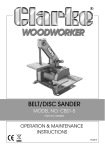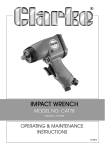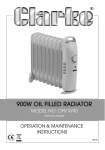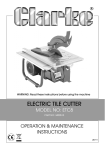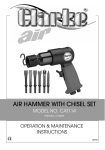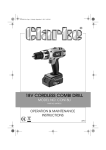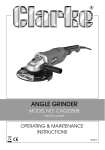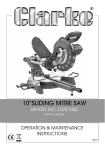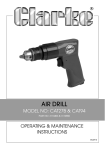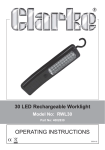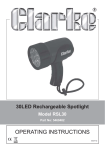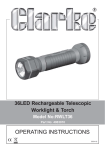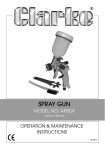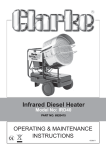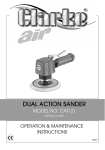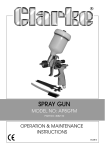Download Clarke HFBC12-24 Specifications
Transcript
HIGH FREQUENCY AUTOMATIC BATTERY CHARGER MODEL NO: HFBC12-24 PART NO: 6267005 OPERATION & MAINTENANCE INSTRUCTIONS LS0814 INTRODUCTION Thank you for purchasing this CLARKE High Frequency Automatic Battery Charger. Please read this manual thoroughly, before attempting to operate, and carefully follow all instructions given. It is vitally important that ALL precautions are taken, as specified, which will not only provide protection for yourself and that of others around you, but will also ensure that the Battery Charger will give you long and satisfactory service. GUARANTEE This CLARKE product is guaranteed against faulty manufacture for a period of 12 months from the date of purchase. Please keep your receipt as proof of purchase. This guarantee is invalid if the product is found to have been abused or tampered with in any way, or not used for the purpose for which it was intended. Faulty goods should be returned to their place of purchase, no product can be returned to us without prior permission. This guarantee does not effect your statutory rights. ENVIRONMENTAL RECYCLING POLICY Through purchase of this product, the customer is taking on the obligation to deal with the WEEE in accordance with the WEEE regulations in relation to the treatment, recycling & recovery and environmentally sound disposal of the WEEE. In effect, this means that this product must not be disposed of with general household waste. It must be disposed of according to the laws governing Waste Electrical and Electronic Equipment (WEEE) at a recognised disposal facility. 2 Parts & Service: 020 8988 7400 / E-mail: [email protected] or [email protected] THE CHARGING PROCESS The HFBC12 has a sophisticated computer system that performs a 7 stage automatic charging cycle. The stages of this charging cycle are as follows: STAGE 1 DIAGNOSIS (UPON CONNECTION TO THE BATTERY) • Polarity check: to make sure that the connections are correct. • Battery check: to make sure that the battery can accept a charge and is not faulty, if it is the charger will not attempt to charge the battery. Warning LEDs will come on if either test fails. STAGE 2 PRE-CHARGE STAGE 3 SOFT START STAGE 4 CONSTANT CURRENT Charges a discharged battery at a constant current depending on charge mode selection. Charges until the battery is 80-90% re-charged. STAGE 5 CV(CONSTANT VOLTAGE) This is a charging cycle for batteries nearly full. It will top off the battery to a full charge. STAGE 6 RESTING Cuts off automatically when a full charge is reached. STAGE 7 RESTORING Automatic On-off Monitoring. The charger will maintain and optimise the battery indefinitely so long as it remains connected to the battery. If the battery falls below 12.8V DC, the charger will restart at stage one. 3 Parts & Service: 020 8988 7400 / E-mail: [email protected] or [email protected] SAFETY PRECAUTIONS WARNING: BECAUSE HIGHLY INFLAMMABLE HYDROGEN GAS IS RELEASED IN THE PROCESS OF BATTERY CHARGING, PLEASE REMEMBER TO SWITCH OFF THE CHARGER FIRST, AND SO AVOID SPARKING WHICH WILL OCCUR WHEN CONNECTING OR DISCONNECTING LIVE LEADS. PLEASE READ BEFORE USING THIS UNIT 1. Battery acid is highly corrosive. If spillage occurs, wipe off immediately and wash copiously with water. Particularly avoid contact with the eyes, but if this occurs, you must seek medical advice. 2. When charging is completed, ensure that the vehicle battery leads are secured to the proper terminals which should be clean, and lightly smeared with petroleum jelly to prevent corrosion. Finally, re-check the electrolyte level. 3. Do not expose this charger to rain. 4. Never touch together the negative and positive leads on this unit whilst the unit is switched on. 5. Never attempt any electrical or mechanical repair. If you have a problem with your machine contact your local stockist for service information. WARNING: CERTAIN TYPES OF SEALED OR MAINTENANCE-FREE BATTERIES NEED EXTRA CARE WHEN CHARGING. PLEASE CONSULT BATTERY MANUFACTURERS INSTRUCTIONS BEFORE USING THIS UNIT. WARNING: SINCE TOXIC FUMES MAY BE RELEASED DURING BATTERY CHARGING, ONLY USE THIS UNIT IN A WELL VENTILATED AREA. 6. Before charging ensure the battery terminals are clean and that the cells are filled with electrolyte to the correct level by adding distilled water where necessary. 7. This appliance is not intended for use by persons (including children) with reduced physical, sensory or mental capabilities, or lack of experience and knowledge, unless they have been given supervision or instruction concerning use of the charger by a person responsible for their safety. Children should be supervised to ensure that they do not play with the charger. 4 Parts & Service: 020 8988 7400 / E-mail: [email protected] or [email protected] ELECTRICAL CONNECTIONS WARNING! Read these electrical safety instructions thoroughly before connecting the product to the mains supply. Before switching the product on, make sure that the voltage of your electricity supply is the same as that indicated on the rating plate. This product is designed to operate on 230VAC 50Hz. Connecting it to any other power source may cause damage. This product may be fitted with a non-rewireable plug. If it is necessary to change the fuse in the plug, the fuse cover must be refitted. If the fuse cover becomes lost or damaged, the plug must not be used until a suitable replacement is obtained. If the plug has to be changed because it is not suitable for your socket, or due to damage, it should be cut off and a replacement fitted, following the wiring instructions shown below. The old plug must be disposed of safely, as insertion into a mains socket could cause an electrical hazard. WARNING! The wires in the power cable of this product are coloured in accordance with the following code: Blue = Neutral Brown = Live If the colours of the wires in the power cable of this product do not correspond with the markings on the terminals of your plug, proceed as follows. • The wire which is coloured Blue must be connected to the terminal which is marked N or coloured Black. • The wire which is coloured Brown must be connected to the terminal which is marked L or coloured Red. Plug must be BS1363/A approved. Always fit a 13 Amp fuse. Live Neutral (Brown) (Blue) Ensure that the outer sheath of the cable is firmly held by the clamp We strongly recommend that this machine is connected to the mains supply via a Residual Current Device (RCD) If in any doubt, consult a qualified electrician. DO NOT attempt any repairs yourself. This symbol indicates that this is a Class II product, and does not require an earth connection. 5 Parts & Service: 020 8988 7400 / E-mail: [email protected] or [email protected] OVERVIEW 1 Handle 11 NEGATIVE (BLACK) lead 2 12 V Selected LED 12 Wrong Connection LED 3 24 V Selected LED 13 Bad Battery LED 4 Power LED 14 Battery Voltage Selector 5 Charging LED 15 Run / Stop Button 6 Full Charge LED 16 Charging Current Selector 7 75% Full LED 17 2 Amp Trickle Charge LED 8 50% Full LED 18 10 Amp Mid Charge LED 9 Low Level LED 19 20 Amp Quick Charge LED 10 POSITIVE (RED) lead 6 Parts & Service: 020 8988 7400 / E-mail: [email protected] or [email protected] PREPARATION 1. If it is necessary to remove the battery from a vehicle to charge it, always remove the grounded terminal from the battery first. Make sure that all accessories in the vehicle are off to prevent sparking. 2. During charging, make sure that the area around the battery has good airflow. 3. Clean the battery terminals. Be careful to keep corrosion from coming in contact with eyes. 4. Add distilled water to each cell until the battery acid reaches the level specified by the battery manufacturer. This helps remove unwanted gas from the cell. Do not overfill. For a battery without cell caps, follow the manufacturer's instructions. 5. Study all the battery manufacturer's specified precautions: for example, removing or not removing cell caps while being charged, and recommended rates of charge. 6. Refer to the vehicle manual to find the voltage of the battery and make sure that the output voltage switch is set at the correct voltage. 7. If the charger has adjustable charge rate, charge the battery initially at the lowest rate. CHARGER LOCATION 1. Place the charger as far away from the battery as possible. 2. Do not position the charger above the battery during the charging procedure. Gases from the battery will cause corrosion and damage the charger. 3. Do not let battery acid drip on the charger when reading specific gravity or when you fill the battery. 4. Do not operate the charger in a closed in area, or decrease airflow in any way. 5. Do not place the battery on top of the charger. 7 Parts & Service: 020 8988 7400 / E-mail: [email protected] or [email protected] CONNECTING TO A BATTERY WARNING: A SPARK NEAR THE BATTERY MAY CAUSE BATTERY EXPLOSION. TO REDUCE THE RISK OF A SPARK NEAR THE BATTERY: • Turn off the charger before you connect/disconnect the DC output clips. • Do not let the clamps touch each other. • Attach the clamps to battery terminals and make sure that you get a good connection. BATTERY IS INSTALLED IN THE VEHICLE 1. Route the leads carefully to decrease the risk of damage by the bonnet, door, or engine parts. 2. Keep away from the fan blades, belts, pulleys, and other parts that can cause injury. 3. Check the polarity of the battery posts. 4. Refer to the vehicle manual to find out if the vehicle has a Negative or Positive earth. • For negative earth vehicles, connect the POSITIVE (RED) lead from the battery charger to the POSITIVE terminal on the battery. Connect the NEGATIVE (BLACK) lead to the vehicle chassis or engine block away from the battery. Do not connect the lead to the carburetor, fuel lines, or sheet metal body parts. Connect to a heavy metal section of the frame or engine block. • For positive earth vehicles, connect the NEGATIVE (BLACK) lead from the battery charger to the NEGATIVE terminal on the battery. Connect the POSITIVE (RED) lead to the vehicle chassis or engine block away from the battery. Do not connect the lead to the carburetor, fuel lines, or sheet metal body parts. Connect to a heavy metal section of the frame or engine block. 5. When charging is completed, switch off the charger and disconnect the plug from the power supply, Remove the lead from the vehicle chassis, and then remove the lead from battery. 8 Parts & Service: 020 8988 7400 / E-mail: [email protected] or [email protected] BATTERY HAS BEEN REMOVED FROM THE VEHICLE 1. Make sure that you know the polarity of the battery posts. 2. Connect the POSITIVE (RED) lead to the POSITIVE post on the battery. 3. Position yourself and the free end of the NEGATIVE (BLACK) lead as far away from the battery as possible. 4. Reach over and connect the NEGATIVE (BLACK) lead at arms length to the NEGATIVE post on the battery. • Do not face the battery when you make this last connection. 5. When you disconnect the charger from the battery always do it in the opposite order to the sequence of connection and break the first connection at arms length from the battery. NOTE: A marine (boat) battery must be removed and charged on shore. To charge it on board requires equipment specially designed for marine use. OPERATION TO CHARGE THE BATTERY 1. Connect the charger to the battery (see page 7). 2. Connect the charger to the mains supply. • You will hear a beep if the battery is connected correctly. • If the charger senses an incorrectly connected battery, then the “Wrong Connection” or “Bad Battery” LED will come on. You MUST connect the battery correctly before you continue. 3. Use the Battery Voltage Selector button to select 12V or 24V. • The corresponding LED will come on. 4. Use the Charging Current Selector button to set the charging current. • 2 amp - Trickle Charge, 10 amp - Midi Charge, 20 amp - Quick Charge 5. Push the Run / Stop button to start the charging process. • The Charging LED will come on. 9 Parts & Service: 020 8988 7400 / E-mail: [email protected] or [email protected] WHEN CHARGING IS COMPLETE 1. When charging is complete the green Charged LED will come on. 2. Switch off the charger and disconnect the plug from the power socket. 3. Remove the leads from the battery as described in the previous sections. STORAGE Store the mains lead and clamps in the compartment shown when not being used. MAINTANENCE This charger requires minimal maintenance. As with any appliance or tool, a few common sense rules will prolong the life of the battery charger. WARNING: ALWAYS BE SURE THE CHARGER IS UNPLUGGED BEFORE PERFORMING ANY MAINTENANCE OR CLEANING. 1. Keep in a clean, dry area. 2. Wind up the leads when not in use. 3. Clean the case and leads with a moist cloth. 4. Clean corrosion from the clamps with a solution of water and baking soda. 5. Examine the leads at regular intervals for damage and have them replaced if necessary. WARNING: ALL OTHER SERVICING/REPAIRS SHOULD BE DONE BY QUALIFIED PERSONNEL ONLY. 10 Parts & Service: 020 8988 7400 / E-mail: [email protected] or [email protected] PARTS DIAGRAM 11 Parts & Service: 020 8988 7400 / E-mail: [email protected] or [email protected] PARTS LIST NO DESCRIPTION 1 PART NO Black Clip GRHFBC122401 2 Clapboard GRHFBC122402 3 Main PCB GRHFBC122403 4 Front Case GRHFBC122404 5 Front Panel with label GRHFBC122405 6 Rear case GRHFBC122406 7 Red Cable / Clamp GRHFBC122407 8 Power Cord GRHFBC122408 9 Cover GRHFBC122409 10 Handle GRHFBC122410 11 Screw GRHFBC122411 12 Black Cable / Clamp GRHFBC122412 12 Parts & Service: 020 8988 7400 / E-mail: [email protected] or [email protected] TROUBLESHOOTING Problem Cause Solution Bad Battery light comes on The battery voltage is between 0.5V and 1.5V. Have the battery tested by a qualified technician; The battery voltage is lower than 11V(12V),22V(24V) after being charged for 4 minutes. Replace the bad battery if necessary. The battery voltage drops below 12V, 24V two minutes after being fully charged. Couldn't reach fully charged status in 24 hours. Battery does not charge Lack of AC input power. Make sure that the charger is plugged into AV outlet and the POWER LED is lit. Faulty connections to battery terminals. Unplug the charger and check the battery connection; ensure that there is a good connection at the battery terminal/post and/or vehicle chassis.. Wrong charge voltage selection. Check that the correct charge voltage was selected for the battery being charged.. Battery voltage too low. Ensure enough charging time was allowed to charge battery. Charging a very cold battery. If the battery being charged is extremely cold (below freezing), it will not accept a high rate of charge, so the initial charger rate will be slow. The rate of charger will increase as the battery warms. Never attempt to charge a frozen battery. 13 Parts & Service: 020 8988 7400 / E-mail: [email protected] or [email protected] SPECIFICATIONS Model Number HFBC12-24 Battery Voltages: 12V, 24V IP Rating IP20 Minimum Battery Size 5 AH Maximum Battery Size 200 AH Operating Temperature Range 0 to 40°C Dimensions (D x W x H) 170 x 265 x 180 mm Weight 2.3 kg 14 Parts & Service: 020 8988 7400 / E-mail: [email protected] or [email protected] DECLARATION OF CONFORMITY 15 Parts & Service: 020 8988 7400 / E-mail: [email protected] or [email protected]
















